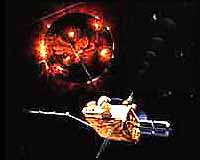 |
Washington (AFP) June 30, 2009 US and European scientists were Tuesday bidding farewell to the tenacious solar probe Ulysses which has been recording data around the sun for more than 18 years, four times longer than planned. "Ulysses has taught us more than we ever expected about the sun and the way it interacts with the space surrounding it," said Richard Marsden, Ulysses project manager with the European Space Agency (ESA). ESA and the US space agency were planning to send their final radio communication to the lonely Ulysses at 1535 GMT, and then pull the plug on the probe as it floats further and further away from Earth. Since its launch into space in October 1990, Ulysses, named after the king of Ithaca in Greek mythology, has scanned the far reaches of the sun on a journey which has taken it some nine billion kilometers (5.5 billion miles). One of its discoveries was that the magnetic fields of the sun spread their influence across the whole solar system, something that had previously not been known. "This is very important because regions of the sun not previously considered as potential sources of hazardous particles for astronauts and satellites must now be taken into account," said Marsden. Ulysses also helped to prove that during much of the sun's 11-year solar cycle, solar winds travel nearly twice as fast as had been believed. Scientists originally thought that the speed of solar wind -- a constant stream of particles emitted by the sun -- was about 400 kilometers (250 miles) per second. The probe also detected and analyzed cosmic dust flowing into our solar system from deep space, showing that it was at least 30 times more abundant than astronomers had thought. Unexpectedly, new measurements of helium isotopes created billions of years apart also confirmed cosmological theories about the Big Bang -- and the likely fate of the Universe. NASA and ESA were planning to send their final communication from the Jet Propulsion Laboratory in Pasadena, California. After that Ulysses, weighing some 379 kilos (830 pounds) with 10 observation instruments on board, will float free. Share This Article With Planet Earth
Related Links Solar Science News at SpaceDaily
 Ulysses Mission Coming To An End
Ulysses Mission Coming To An EndParis, France (ESA) Jun 29, 2009 Upon receipt of the last command from Earth, the transmitter on Ulysses will switch off on 30 June, bringing one of the most successful and longest missions in spaceflight history to an end. After 18.6 years in space and defying several earlier expectations of its demise, the joint ESA/NASA solar orbiter Ulysses will achieve 'end of mission' on 30 June 2009. The final communication ... read more |
|
| The content herein, unless otherwise known to be public domain, are Copyright 1995-2009 - SpaceDaily. AFP and UPI Wire Stories are copyright Agence France-Presse and United Press International. ESA Portal Reports are copyright European Space Agency. All NASA sourced material is public domain. Additional copyrights may apply in whole or part to other bona fide parties. Advertising does not imply endorsement,agreement or approval of any opinions, statements or information provided by SpaceDaily on any Web page published or hosted by SpaceDaily. Privacy Statement |